A licensed outdoor guide for twenty years Glenn Kreisberg is also a radio frequency engineer, writer and researcher who currently serves as Vice President of the New England Antiquities Research Association ( www.NEARA.org ). He’s researched and published articles and interviews on electromagnetism and the ancients, historic bluestone quarrying in upstate New York and lithic sites and alignments in the northeast U.S., among others. Glenn is also the current editor of the Author of the Month page featured at grahamhancock.com as well as the founder and editor of the alternative science and history web site www.ASHnews.org. He resides in Woodstock N.Y. with his wife and two children.
His first book, an edited anthology of essays titled Lost Knowledge of the Ancients, is out now by Bear & Co. Inner Traditions.
INTRODUCTION
The stone constructions discussed in this paper represent the discovery of a petroform, i.e. a purposeful arrangement in rock or stone which may be geometric, animal or human in shape. Covering an area of several acres on a southeastern facing slope of Overlook Mountain in Woodstock, New York, a grouping of very large, carefully constructed lithic formations, when connected together and taken as whole, appear to create a serpent or snake figure or effigy. The large stone constructions, consisting of 6 very large stone cairns, along with 2 snake effigies/serpent walls, are surrounded by a few dozen, much smaller stone cairns arranged in clusters and rows. Native American seasonal habitation sites have been documented nearby dating to 4000 years BPE and the site, in recent years, was visited by a Native American Tribal Preservation Officer who, along with many other individuals who have visited the site, felt great awe, wonder and deep respect for the ancient stone symbols present at the site. If the petroform is confirmed as authentic and constructed in antiquity, it can be inferred that the site was at one time (and still should be) considered “sacred”. Additionally, because of the close correlation between the two representations, it is proposed that the snake symbol petroform created by the large lithic structure on Overlook Mountain may represent the star constellation Draco (the Dragon).
HISTORY AND DISCRIPTION OF SITE
Overlook Mountain has long struck an iconic image looming above the Hudson River Valley, acting as sentry to the eastern most woodland slopes of Catskill Mountains in upstate New York. Drawn to those slopes for thousands of years humans have worked and roamed there as prehistoric hunter gatherers, early agrarians, colonial lumber cutters and hide tanners, early American glass blowers and quarrymen, and 20th century Utopians, hikers and hunters. With such a long and varied past, it’s safe to say, Overlook Mountain can be recognized as a serial use area; an area used by many different groups of people, for many different purposes and reasons, for thousands of years.
Beyond that, Overlook Mountain has inspired, enlightened and invoked. From practical to artistic and spiritual, the Mountain has been the source and subject of countless paintings, drawings, illustrations, meditations, poetry and books, all seeking in some way to capture, experience and ultimately document the essence and nature of the tangible as well as intangible aspects the mountain possesses.
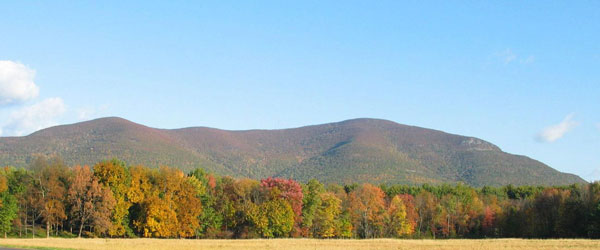
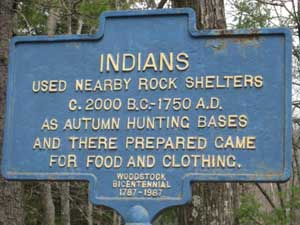

There is little doubt an aspect of paramount importance to the early indigenous dwellers of Overlook Mountain and the lands surrounding, whose connection to the natural world was both intimate and profound compared to this day and age, would have been the relationship and connection between the mountain and the sky.
My interest in the history of Overlook Mountain began in 2004 when a cell tower was proposed for the California Quarry, a historic bluestone quarry on the lower slopes of the mountain which operated from the 1830’s to the 1890s. During that period The California Quarry along with other, smaller, surrounding quarries, contributed greatly to early American industry and commerce in the region. While researching the quarry property I was introduced to the many “stone mounds” that were present on the 196 acre quarry property and nearby adjacent parcels. Early property deeds for the area show “ancient stone monuments” present from the first land grants, patents and subdivisions recorded.
In all, nearly 5 dozen cairns have been identified on the southeastern slopes of Overlook Mountain between an elevation of 1100 and 1500 feet. Most of the cairns are well formed and show deliberate construction techniques and practices such as dry stacking and the use of retaining walls. In some cases it appears quartzite and hematite “donation” stones, which are not structural in nature, were left on the piles.


The construction of the cell tower caused the destruction of 5 of the nearly 60 stone cairns present in the vicinity. In 2006 as part of the cell tower application review process, Sherry White, Tribal Preservation Officer of the Stockbridge Munsee Community Band of Mohican, visited the cairns and expressed the belief that the larger of the structures could be memorial or “burial” cairns. Having toured the entire site, it was her belief the Overlook Mountain cairn complex can likely be seen as a “sacred precinct” where memorial or burial cairns were constructed locally, over many successive generations, and perhaps, as part of a much wider spread, spiritual, ritualistic, ceremonial practice and belief. Due to the presence of cultural resources of historic (and perhaps prehistoric) significance at the site, a National Register of Historic Places application for the California Quarry property was prepared, submitted and is currently in review and pending with the New York State Office of Parks, Recreation and Historic Preservation.
In 2008 members of the New England Antiquities Research Association (NEARA) visited the site along with researchers from the New York State Museum in Albany. Museum GIS specialist Susan Winchell-Sweeney conducted a GPS site survey documenting the quantity and location of the remaining stone constructions. In all, 6 very large cairns (up to 100 ft in length), 46 small cairns (up to 10 ft in length), 2 “snake” effigies or “serpent “ walls (90’) and 2 springs were identified and their size and location data recorded.

After receiving the above plotted site data image from Susan Winchell in late 2008 I initially made little of the distribution, concentration or configuration of the several dozen plotted points. There did seem to be deliberate groupings and clusters of the smaller cairns while the “great” cairns appeared to be spread about more randomly. But nothing really jumped out at me. It wasn’t until about a year later (late 2009), that I revisited the data image with the intention of “connecting the dots”.
My good friend and fellow NEARA member David Holden, who had first introduced me to the cairns, had suggested that perhaps connecting the points could reveal a pattern which he believed, on a hunch, could depict the Pleiades star cluster. Somewhat skeptical, I decided to conduct the exercise of tracing the dots onto a piece of paper and comparing them to a star chart of the northern constellations. Susan Winchell’s data revealed there were 8 large stone constructions seemingly, randomly scattered about the mountain side site, 6 “great” cairns and 2 “snake” effigy walls, each separate construction from 50’ – 100’ in length. I decided to start by tracing the point of those 8 locations to a piece of paper. I then connected the dots with straight lines in the only obvious and logical manner possible.
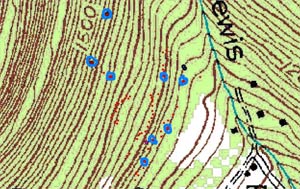 Image of the plotted GPS data points and location of the 8 large lithic constructions |
 Image showing tracing of the 8 large lithic constructions |
|
 |
 |
By comparing the tracing to the constellations we see only one match that comes close. The constellation Draco, known as the serpent or snake constellation, is a close match in shape, configuration and layout, to the position of the stone mound constructions laid out on the ground. In fact, by mirroring the image of the cairn configuration we see what appears to be an image of the constellation Draco reflected from the sky.

It should be pointed out; the eight points used to create the snake figure, were not “cherry picked”, but were distinguished from the rest of the cairns by size and the fact that the large construction (50′ -100′ in size) appear to be randomly placed as opposed to the smaller cairns (6 – 10′ in size) which appear in organized rows and clusters. Sorting artifacts by features such as size and relative position, I believe, is a standard method of classification and in this case provides the basis for determining the stone mounds that constitute the petroform on Overlook Mountain.

COMPARITIVE AND DESCRIPTIVE ANALYSIS
Draco is the 8th largest constellation, occupying over 1,000 square degrees in the sky as it winds from the Pointers of Ursa Minor nearly to Vega in Lyra. Yet it has no bright stars. Gamma-Draconis, or Eltanin, the brightest star of Draco, has a magnitude 2.2 and is one of three or four stars that typically represent the head of the serpent. It is famous for being the star observed by the 18th-century English astronomer James Bradley when he was trying to detect parallax and so calculate the distance. Since the star Eltanin is considered the brightest star in the constellation it is most likely to be seen as the star representing the head of the serpent on the Overlook representation, which appears to be consistent between the two representations. The spacing and angle between the stars of the two representations, while close, is not an exact match and the angle between Altais and Eltanin would also suggest that Eltanin is the single “head” star in the Overlook Draco representation as opposed to Rastaban.
The total number of stars which represent the constellation Draco can vary from 9 to 14 depending on the culture on which the representation is based. The constellation Draco has 7 stars that are less than 10 parsecs (32 light years) from the Sun, has 3 stars brighter than 3.00 magnitude, and six that are currently know to have planets. The total number of stars represented in the Overlook/ Draco depiction is 8.
I thought it might be interesting to compare the magnitude or apparent brightness of the stars that comprise Draco to the size of the cairns on the ground to determine if there any correlation between size and brightness. The chart below lists the stars in Draco by magnitude and is followed by a chart listing the corresponding “Great Cairns” and their respective sizes.
Below is a chart of the eight brightest stars in the constellation Draco, from tail to head and their Apparent Magnitude. Also below is a chart with the Great Cairns and their respective sizes.
| Star | Mag | Great Cairn | Size (ft) |
| Giausar | 4.1 | GC 6 | 50′ |
| Kappa Draconis | 3.88 | GC5 | 50’ |
| 3.64 | GC 4 | 90′ | |
| Edasich | 3.22 | GC 3 | 60′ |
| 2.73 | GC 2 | 60′ | |
| 5.7 | GC 1 | 60′ | |
| 4.7 | Snake Effigy II | 90′ | |
| Eltanin (Head) | 2.42 | Snake Effigy I | 90′ |

Images showing three of the six “great” cairns comprising the configuration documented on Overlook Mountain
A description of the individual component constructions that constitute the Overlook Mountain petroform follows: Beginning with the two serpents or snake effigy walls located at the highest elevation (1420’) of the eight locations involved. The eastern most of these two walls would serve as the head of the larger, component serpent (Draco?) petroform. The two slightly curving stone walls, each approximately 90’ long, end at a large glacial erratic which serves as a head to each individual effigy form. It would appear the area around where the figures mouth would be located on the glacial erratic, has been worked to accentuate the appearance of the mouth. The two walls, whose tails point towards one another, are located approximately 100 yards apart and are visible to and from each other when foliage is lacking, if one knows where to look. In fact it was determined during a recent winter site visit that each of the large constructions is visible from the next nearest petroform component. The six “great” cairns making up the remaining, lower portion of the petroform (between 1140’ – 1300’ elv.) range from approximately 60’ to 90’ in length and are elongated, oval or crescent shaped. The three largest of the “great” cairns are curving or “horned” shaped and employ the use of retaining walls on the downward slope to allow the high piling up of the stones within, in some place to a height of 12’.
NATIVE STONE CONSTRUCTIONS
According to Edward Lenik, “Serpentine images carved into non-portable rock surfaces and on portable artifacts were invested with ideological and cultural significance by American Indian people in the Northeast. in his book Picture Rock- American Indian Rock Art in the Northeast Woodlands, Lenik further states “Snakes or serpents are ancient symbols and appear in rock art sites across North America. They are considered to be creatures of great power and craftiness. Among Algonquian speaking peoples, they may have represented evil and darkness or the energy of life or regeneration, or served as vehicles of transition for the soul of the deceased to the spirit world.” Could the Overlook Mountain Petroform function as a guardian of the pathway souls follow to the heavens? Lenik also associates the Algonquin mythical Thunderbird as a guardian of humans against the Great Serpent of the underworld. If the Thunderbird is seen as the symbol of the protection of life, could the Serpent represent protection of the pathway of the dead?
Accounts of Native American stone constructions associated with definite astronomical attributes are not unique. Research in Manitou – The Sacred Landscape of New England’s Native Civilization, by James Mavor and Byron Dix, went a long way toward proving the Native culture of the northeast America built with stone and that many of these constructions were associated with astronomical alignments and observations. This should not be surprising as examples of this apparently geographically diverse cultural practice are well documented throughout the Americas, and in fact worldwide.
Examples of stone serpent effigy mounds exist and have been documented. It has been noted in Boyd County Kentucky, an apparent stone serpent effigy (“a wavy continuous line with snake-like configurations”) can be found. Brisbin (1976) was the first to describe this serpent effigy. Sanders’ (1991) article includes a nice drawing of the site, and notes that it is “unique for its much larger size, well-defined serpent outline, strikingly bifurcated tail, and associated stone ring, which may represent an egg.” (Not dissimilar to the Ohio Serpent Mound). This effigy is said to have a solar alignment in the configuration of the head and tail. Brisbin notes also that the sandstone forming the “serpent” was quarried locally, and that “in the head and coil portion, the stones are regularly piled to a height of 12 feet, but in the area of the body, they are stacked about 4 feet high and 5 feet wide until they thin out in the tail.”Sanders gives a little more up-to-date information on the site. It is owned by Ashland Oil, Inc. The company has established a 90 m buffer between the mound and a non-toxic landfill which serves an Ashland Oil refinery. The head of the serpent has been damaged by both pits excavated into the rock by unknown individuals and by the construction of a radio tower access road.
In another example; a preliminary investigation at the Skeleton Mountain site, 1CA157, Calhoun county, Alabama by the Jacksonville State University Archaeological Resource Laboratory (JSU-ARL), begun 2007 states, “Native Americans are the likely candidates for the effigy construction.” and further. “one of the strongest reasons for believing the Skeleton Mountain Snake Effigy Site, 1Ca157, and other stone structures are an integral part of the Native American belief system has recently been expressed in a resolution introduced by the United South and Eastern Tribes (USET) at the Impact Week Meeting held in February of 2007 in Arlington, Virginia”
Referring to ‘similar stone structures in Tennessee: “The walls have been radiocarbon dated from AD 230 to AD 430, during the Middle Woodland period. ” in Georgia: “The three dates from the soil within the stone matrix immediately above the original ground surface (Layer 2) ranged from AD 3 to AD 1075 while the soil directly underneath the stones was dated to AD 1101, suggesting the mound was constructed during the Late Woodland to early Mississippian time period. ”
Further, we find specific examples of Native American petroform matching the constellations exist as well. In his paper Star-Beings and Stones: Origins and Legends, researcher Herman Bender argues convincingly for a petroform in Wisconsin, known as the Kolterman Petroform Effigy, consisting of stone ‘stickman’ formations constructed on the ground which create human figures known as ‘star beings’. The effigy figures are said to be associated with and the Native American Thunderbird tradition and mirror on the ground the constellations Libra and Scorpio as they appear in the night sky.
In the case of the Overlook Mountain petroform, the comparison to the star group known as Draco, cannot help but be made. I have consulted with Astronomer Kenneth Leonard, who published Calendric Keystone (?) The Skidi Pawnee Chart of the Heavens: A New Interpretation and have confirmed the constellation Draco would be visible rising above the summit of Overlook Mountain directly to the north before it reached its’ zenith overhead during daylight hours. And further confirming the assertion, using Starry Night Pro computer modeling astronomy software demonstrates that Draco rose above the mountain on Feb. 1st 2700 BCE, (when Thuban was pole star) just before sunrise. And, the serpent constellation has continued to rise over Overlook Mountain, throughout the night for thousands of years since, occupying a permanent position perpetually spinning around the fixed Celestial North Pole.
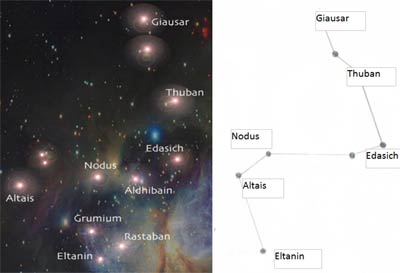
This is significant because to early sky watchers living in the Hudson Valley, occupying lands stretching for miles to the south, east and west, Overlook Mountain would have been the place to look towards to see the Serpent of the North rising, night after night, to fulfill its duties protecting and making “precession proof” the heavens. This is important because, by “precession proof” I mean no matter where the celestial pole drifted over time (due to precession), the dutiful dragon would always appear wrapped around that point diligently spinning about the celestial pole, marking its location for those watching. We must remember that no star ever marks the exact celestial pole, which is the point in space where the Earth’s Axis points and which also draws a slow circle in the heavens, (24,000+ years) due to the apparent wobble of precession. What we consider the “North Star” now, Polaris, is merely the star that closest marks the exact, true Celestial Pole. This star changes over time due to precession: More on this and Thuban, the past Pole Star, later.
Besides the connection to the sky, the connection of this mountain to the serpent or snake is also undeniable and I don’t see this likely a coincidence since Overlook Mountain has the highest population of Eastern Rattlesnake in New York State according to the Department of Environmental Conservation (DEC). It is estimated, based on the wear marks on the bedrock at the den entrances, some of the rattler habitats have existed for centuries, at least. I think this is significant given the reverence the snake was accorded by the indigenous people and helps complete the picture of the sacred nature of the mountain in the culture of the Native population.
SERPENT MOUND AND CAMBODIAN CONNECTION
Documented images of snakes and serpents are not uncommon in the northeastern woodlands and elsewhere and at least one significant Native American example is claimed to have a connection specifically with the constellation Draco. It is said The Serpent Mound of Ohio may have been designed in accord with the pattern of stars composing the constellation Draco. The star pattern of the constellation Draco fits with fair precision to the Serpent Mound. The fact that the body of Serpent Mound follows the pattern of Draco may support various theses. Putnam’s 1865 refurbishment of the earthwork was correctly accomplished and a comparison to Romain’s or Fletcher and Cameron’s maps from the 1980s show how the margins of the Serpent align with great accuracy to a large portion of Draco.
Some researchers date the Serpent Mount earthwork to around 5,000 years ago, based on the position of the constellation Draco, through the backward motion of precession, when the star Thuban, also known as Alpha Draconis, was the Pole Star. Alignment of the effigy to the Pole Star at that position also shows how true north may have been found. This was not known until 1987 because lodestone and modern compasses give incorrect readings at the site. Most scholars date the Serpent Mound to the Adena culture which flourishers from 1000 to 200 BCE. Though little details are known regarding the religious beliefs and rituals of the Adena, many believe that the Serpent Mound sat at the center of their religious rituals, and may have even served as a pathway for practitioners to walk, chanting hymns and thanking their gods for the continued fertility of the land, and praying for its continuance.
It has been documented that trading territories and routes of the Adena culture extended along the southeaster shores of the Great Lakes, as well as the Hudson, Ohio and St. Lawrence Rivers. So, it is likely some of the religious and ritualistic aspects of the Adena culture diffused to the tribes of those regions and vice versa.
Considering evidence for the possibility of even further diffusion we must look at the temples of Cambodia and in specific, the sacred jungle complex of Angkor Wat. In the book Heaven’s Mirror – Quest for the Lost Civilization, author and researcher Graham Hancock and his wife Santha Faiia document dozens of correlations between sacred construction on the landscape and patterns created by star groups in the sky and/or alignments with solar, lunar and stellar events on the horizon. One remarkable discovery, made in 1996 by one of their Ph.D researchers John Grigsby, was that the layout of the sacred pyramid-temple complex of Angkor Wat in Cambodia, comprised of the fifteen principal constructions spread out across nearly 400 sq km of dense jungle, connected to model the serpent or snake constellation Draco. Using star mapping software it was discovered that the date when the position of the locations making up the “ground Draco” reflected exactly the position on the constellation overhead, was some 10,500 years BC. As commented on by Grigsby “If this is a fluke then it’s an amazing one…

Starry Night Pro screen shot of Draco’s position above Overlook Mountain site coordinates

Above: Draco, Below: Layout of Angko Wat temple complex, Cambodia From: Heaven’s Mirror.
DRACO AND MYTHOLOGY
From antiquity, Draco (the dragon) has long been known as the “serpent” or “snake constellation”. For a period in Human history, the star Thuban in Draco marked the north point in the sky, as Polaris does now. This is a significant fact we’ll take a closer look at that later in this paper.
Ophiolatreia, the worship of the serpent, next to the adoration of the phallus, is one of the most remarkable, and, at first sight, unaccountable forms of religion the world has ever known. Until the true source from where it sprang can be determined and understood, its nature will remain as mysterious as its universality. It is difficult to reconcile mans worship of a creature which is generally found repulsive. Yet there is hardly a country of the ancient world, where it cannot be traced, pervading every known system of mythology, and leaving proofs of its existence and extent in the shape of monuments, temples, and earthworks of the most elaborate and curious character.
Babylon, Persia, India, Ceylon (Sri Lanka), China, Japan, Burma, Java, Arabia, Syria, Asia Minor, Egypt, Ethiopia, Greece, Italy, Northern and Western Europe, Mexico, Peru, America—all yield abundant testimony to the same effect, and point to the common origin of “Pagan” systems wherever found. Whether the worship was the result of fear or respect is a question that naturally enough presents itself, and in seeking to answer it we’re confronted with the fact that in some places, such as Egypt, the symbol was that of a good deity, while in India, Scandinavia, and Mexico, it was that of an evil one, a paradox that no doubt speaks to the struggle between good and evil in humans and a duality pervasive in their nature and the nature of the universe.
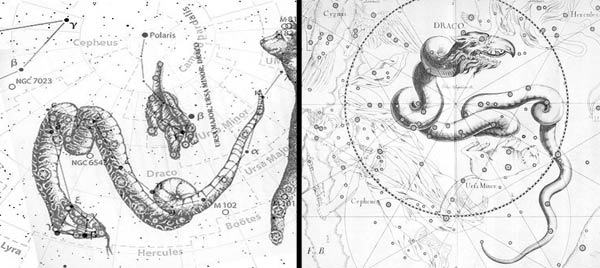
Draco in mythology is most commonly depicted as a coiled snake.
Snakes, Dragons and other similar creatures often played a role in creation myths. In these stories the gods would often battle such creatures for control of the Earth. When defeated, the serpents were flung up into the skies. To the Babylonians, Draco was Tiamat, a dragon killed by the sun god in the creation of the world. To the Greeks, Draco guarded the Golden Apples of the Sun in a magical garden.
In many early cultures the Serpent and the Sun were strongly connected in their belief systems. Native American oral tradition relates how at one time men worshipped reptiles but were later compelled to recognize the Sun, Moon and other heavenly bodies as the only object of veneration. It’s said the old Gods were secretly entombed in earth works built to symbolize and represent the heavenly bodies.
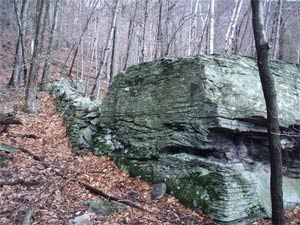
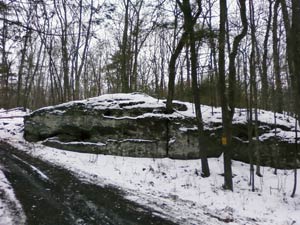
LEFT: Serpent wall/snake effigy. 1 of 2 that are part of the Overlook Mountain Petroform,
RIGHT: Serpent effigy crafted in rock outcropping on the authors driveway.
Serpents are a common feature in the art of the Late Prehistoric Period (900 A.D. to 1650 A.D.). As already mentioned, many American Indians of the Eastern Woodlands believed the Great Serpent was a powerful spirit of the Underworld. Serpent Mounds and snake effigies may be a representation of these beliefs and hold a connection to the cosmos through the constellation Draco.
In Reachable Stars: Patterns in the Ethnoastronomy of Eastern North America, author George Lankford’s volume focuses on the ancient North Americans and the ways they identified, patterned, ordered, and used the stars to enhance their culture and illuminate their traditions. They knew them as regions that could be visited by human spirits, and so the lights for them were not distant points of light, but “reachable stars.” Guided by the night sky and its constellations, they created oral traditions, or myths, that contained their wisdom and which they used to pass on to succeeding generations their particular world view. However, they did not all tell the same stories or see the same patterns. Lankford uses that fact—patterns of agreement and disagreement—to discover prehistoric relationships between Indian groups. In his research, Lankford devoted an entire chapter to “The Serpent in the Stars”, seen usually by the Natives as the Scorpio or Draco constellations.
The great constellation of Draco was seen and revered by most of the civilized cultures and tribes of the Northern hemisphere. The Nordics shaped their great boats in the form of Draco the cosmic dragon. The Native American Indians named their tribes after it, and performed many dances to represent celestial movements. The Irish Druids made good use of the symbol on their monuments. During the time that Draco’s star Thuban was the pole star, it may have appeared to ancient sky watchers that the Earth revolved around Draco.
A symbol of sacred knowledge in antiquity was a tree, ever guarded by a serpent, the serpent or dragon of wisdom. The serpent of Hercules was said to guard the golden apples that hung from the pole, the Tree of Life, in the midst of the garden of Hesperides. The serpent that guarded the golden fruit…and the serpent of the Garden of Eden…are the same – E. Valentia Straiton (The Celestial Ship of the North)
…the nuptial tree, round which coils the serpent, is connected with time and with life as a necessary condition; and with knowledge – the knowledge of a scientific priesthood, inheriting records and traditions hoary, perhaps, with the snows of a glacial epoch – Kennersley Lewis
From these quotes we see that serpent worship was at the heart of human’s earliest religious beliefs. But the concepts involved were far from primitive. Consider the mythological serpent as a representation of the constellation Draco and the tree of life as the pole or axis on which the Earth spins. Through the association of the serpent and the tree, and the position of the stars relative to the Earth’s axis (precession), the importance placed on the certainty of this relationship by the ancients becomes clearer. And, why any disturbance in that relationship, metaphorically and perhaps literally, could portend a major imbalance in the energy and natural cycles of the Universe, with the results nearly always disastrous.
THUBAN, THE ONCE AND FUTURE POLE STAR
As mentioned already, due to the precession of the equinox, Thuban, the third star from the tail of Draco, was the naked-eye star closest to the North Pole from 3942 BC, when it moved farther north than Theta Boötis, until 1793 BC, when it was superseded by Kappa Draconis. It was closest to the pole in 2787 BC, when it was less than two and a half arc-minutes away from the pole. This was at the height of the Egyptian Dynastic era and a shaft in the Great Pyramid at Giza points to Thuban as it was the pole star at the time the pyramid was constructed. Thuban remained within one degree of true north for nearly 200 years afterwards, and even 900 years after its closest approach, was just five degrees off the pole. Thuban was considered the pole star until about 1900 BC, when the much brighter Kochab began to approach the pole as well.
Slowly drifting away from the pole over the last 4,800 years, Thuban now appears in the night sky at a declination of 64° 20′ 45.6″, RA 14h 04m 33.58s. After moving nearly 47 degrees off the pole by 10000 AD, Thuban will then gradually move back toward the north celestial pole. In 20346 AD, it will once again be the pole star.

Sky charts showing pole star position over the course of time.
INITIAL CONCLUSIONS AND FURTHER INQUIRY
It can be said the configuration and layout of large stone constructions on Overlook Mountain, consisting of 6 large stone cairns and 2 serpentine walls, when taken as a whole, constitute a component petroform which resembles a snake or serpent. Specifically, in form and composition, the Overlook Mountain petroform, bears a striking similarity to the star constellation Draco. If the Overlook Petroform is not an intentional construction depicting the serpent constellation (Draco) that has risen over the mountain, over the course of time for many centuries, it is a remarkable coincidence. Either way, the presence of the cairn and serpent wall constructions appear to be evidence of significant cultural activity and resources, related to the site.
Careful archaeological and geological inspection and analysis of the cairns and serpent walls could help provide answers as to the age and purpose of those constructions. Studying the settled and compacted soil, particles and pebbles between stones of one cairn and comparing them to others could help determine which of the structures are the oldest or the most recent. That, as well as comparing lichen colony growth rates, from stones on the outer surface of the structures to those on the interior, could help shed light on when the stones were first placed in the cairns and walls. Identifying when could help determine the context within which they were built and the purpose for which they once served, if any.
Could this be more evidence of a diffusion of the Adena, mound building culture into the northeast region? After all, these are mounds we are talking about, albeit mounds made of stone in the northeast. But then again, stone would have been one of the only materials, available in this region, from which to construct mounds. Mound made of stone instead of earth makes sense if there is no earth to use, yet mounds are what you wish to build. And, should we also consider conversely, that the “mound building” concept and culture of the Adena may have spread from the northeast to the Midwest, having first arrived on our eastern shores from Europe, in an early wave of megalithic migration from northwest Europe? Until the full picture is known, this idea should not be ruled out, especially since the case for cultural diffusion and early transoceanic voyages is growing stronger with time.
It’s reasonable to wonder: Were a people and culture present at the Overlook Mountain site that created ritual and ceremonial constructions of stone, exploiting and manipulating the natural environment and materials found there, to express certain aspects of their belief system? Perhaps this was not uncommon. Were landscapes routinely identified and modified appropriately to create relationships between the land and the sky, to venerate and preserve symbols and events associated with celestial observation? Many examples of this have been identified, reported and documented in the northeast and elsewhere. To say the ancient native civilization of the northeast, of the Hudson Valley and Catskills region, did not create these types of sites or recognize a serpent in the stars, in the sky, as did the ancient east Indians, Chinese, Persians, Egyptians, Norse, Celts and more, is to sell short the great thinkers and sky watchers, of the early people, from our own region.
As has been suggested with the serpent mound in Ohio and the sacred temples of Angkor Wat in south east Asia, is the Overlook Mountain serpent petroform a representation on the ground, which is connected to the constellation Draco in the night sky? The crucial question, whether Draco currently or in the past appears in the night sky above the Overlook Mountain has been answered; it has and does. But, does it match up and align with the position of the large cairns and effigies as laid out on the ground? Are the orientation, i.e. the direction, position, layout and configuration consistent, matching or close to the position of the constellation in the sky above? In shape and form I believe yes, but I don’t believe there is an actual, visual line up and alignment based on a fixed orientation, as the ground constructions on Overlook Mountain appear to “mirror” the stars in the sky, creating a negative or opposite image on the ground, something not uncommon among other known ground/sky matches. But, perhaps most critically, considering precession of the equinox, what was the position of Draco above the site, going back hundreds or thousands of years? Starry Night Pro astronomy software shows the constellation Draco raises over Overlook Mountain, visible high and directly above the mountain summit, at various times throughout the night, marking the position of true celestial north, for thousands of years, regardless of the drifting of precession. Further careful examination of the site could point the way to more answers.
Evidence for the veneration of the four directions, north, east, south and west, by the native tribes of America is well documented, dating back to before the time of first European contact and as witnessed by many of the first European colonists to arrive. In many native ceremonial practices, offerings are made to the four directions, relating each to a season and many times a relative. To this group, the pre-European Native Civilization of Northeast America, there was no more sacred and important knowledge than in which direction to face to make such offerings. Keeping track of and preserving that knowledge would have been an important task with both practical as well as ritual aspects, and every opportunity and advantage would have been taken to do so. Knowing the true location of celestial north and tracking it over time would have been the key to accounting for the celestial motion caused by precession, and this may have been the single greatest undertaking of the “big thinkers” of those ancient days.
Until further evidence is found, speaking to the identity and motives of the Catskills stone mound builders, it is hard to make a stronger case for a correlation between the ground constructions on Overlook Mountain and the stars above. However, further research into finding out how the constellations were identified by Native northeasterners, particularly the Algonquin speaking tribes and whether the existence and knowledge of the serpent constellation was present in northeast tribal mythology, or if they identified what Ancient Europeans called “Draco” as a serpent-like creature as well. Such evidence could considerably strengthen the argument for a correlation existing; a correlation, between the earth and sky, between the lithic constructions on Overlook Mountain and the serpent constellation in the stars above, marking the position of the eternal, celestial north. Documenting and confirming this correlation, this serpentine connection between the real and mythical, the grounded and the godly, between man and heaven; this would surely attest to the truly sacred nature of the site and provide a crucial clue to this unfolding mystery; one most deserving of further investigation and serious, scholarly attention.
References
Book Thesis: Does evidence exists to support the theory an ancient cultural group used features in the landscape of the Catskill and Shawangunk Mountains, in upstate New York, to carry out astronomical observations? Did this group preserve the information by manipulating the natural terrain to create alignments thus transforming various landscape features into manmade monuments? Some of the alignments appear to be configured over distances of up to nearly 20 miles. If this could be documented, it would reshape our understanding and concept of what ancient (prehistoric) man knew and was capable of accomplishing.
Bender, Herman,
“Star
Being and Stones: Origins and Legends”
in Indian Stories, Indian Histories: Nova Americana in English,
Giordano and Comba. 2004
Brisbin, L.G. The
stone serpent mound in Kentucky: and other monuments. West
Virginia Archaeologist 25: 26-36. 1976
Broadhurst, P, and
Miller, H., The Sun and The Serpent, Pendragon Press, 1990
Deal,
Michael, Early
Woodland: Northeastern Middlesex Tradition,
Lecture notes, 2001
Hamilton, Ross, The
Mystery of the Serpent Mound,
Random House, 2001
Hirshfeld, Alan,
Parallax:
The Race to Measure the Cosmos.
New York, New York: Henry Holt. 2001
Hancock, Graham,
Faiia, Santha, Heaven’s
Mirror – Quest for the Lost Civilization. Three
Rivers Press, 1998
Holstein, Harry O.
Kreisberg, Glenn,
“The
California Quarry and Nearby Stone Cairns of Woodstock, NY”,
NEARA Journal,
Volume 41, Number 1, Summer, 2007
Lankford,
George E.
Reachable Stars: Patterns in the Ethnoastronomy of Eastern North
America The
University of Alabama Press, 2007
Lenik, Edward,
Picture
Rocks – American Indian Rock Art in the Northeast Woodlands,
University
Press of New England, 2002
Leonard, Kenneth C.
Calendric
Keystone (?) The Skidi Pawnee Chart of the Heavens: A New
Interpretation in
ARCHAEOASTRONOMY:
The Journal of Astronomy in Culture,
Vol.
X, The Center for Archaeoastronomy, University of Texas Press,
Austin, TX
Mavor, James Jr. W.
and Dix, Byron E., Manitou:
The Sacred landscape of New England’s Native Civilization,
Inner
Traditions – Bear & Co. Rochester, Vt, 1989
Muller, Norman,
“Stone
Mound Investigations as of 2009”
in NEARA Journal,
Volume 43, Number 1, Summer, 2009
Oldham,
C.F. The Sun
and the Serpent – A Contribution to the History of
Serpent-Worship, Archibald
Constable & Co., London, 1905
Ritchie,
W. A. and D. W. Dragoo, “The
Eastern Dispersal of Adena.”
American
Antiquity
25:43-50, 1959
Ridpath. Ian and
Tirion, Wil, Stars
and Planets Guide,
Collins, London. Princeton University Press, Princeton, 2007
Sanders, S.L. 1991.
The stone serpent mound of Boyd County, Kentucky: an investigation
of a stone effigy structure. Midcontinental Journal of
Archaeology 16(2): 272-284.
Steinbring,
Jack, “The
Tie Creek Boulder Site,”
in Hlady ed. Ten ThousandYears: Archaeology in Manitoba: Manitoba
Archaeology Society. 1970
Straiton, E.
Valentia, The
Celestial Ship of the North, Kessinger
Publishing, 1992
Winchell-Sweeney,
Susan, Lewis
Hollow GIS site survey,
New York State Museum, Albany, NY, Nov. 2008
Woodward, Susan L.
and Jerry N. McDonald, Indian
Mounds of the Middle Ohio Valley,
Blacksburg, Virginia: The McDonald & Woodward Publishing Company,
1986









